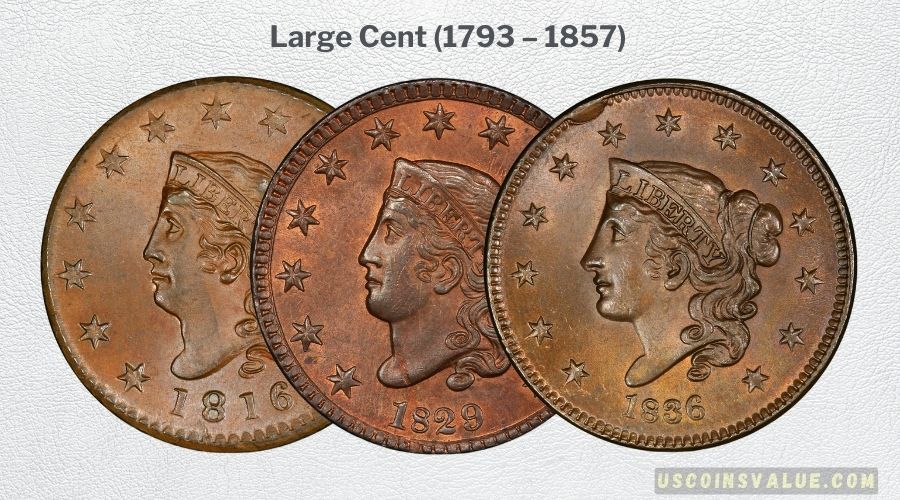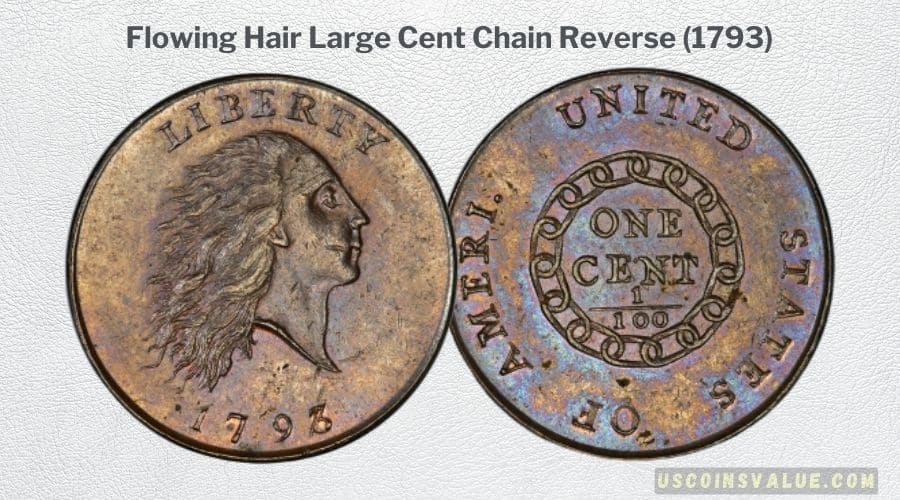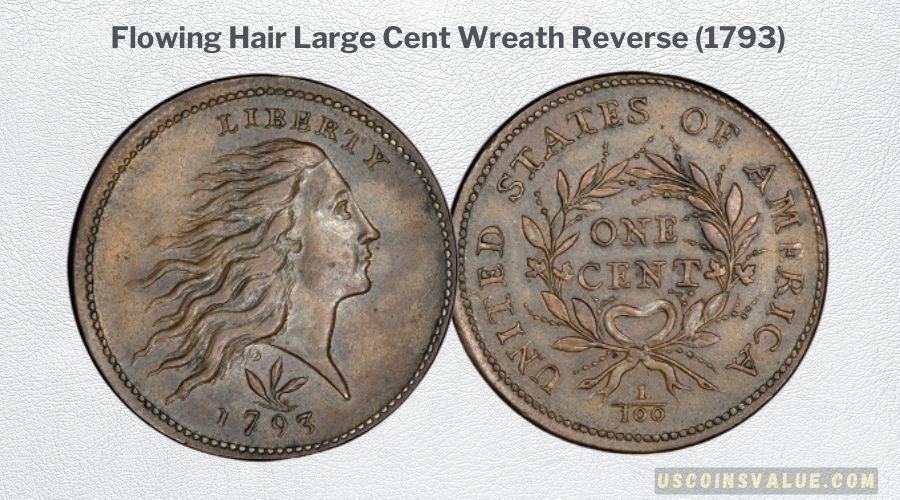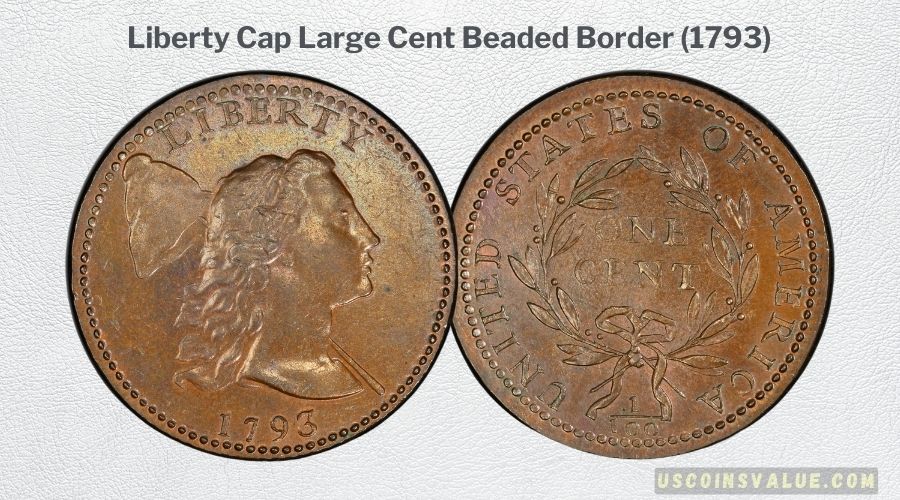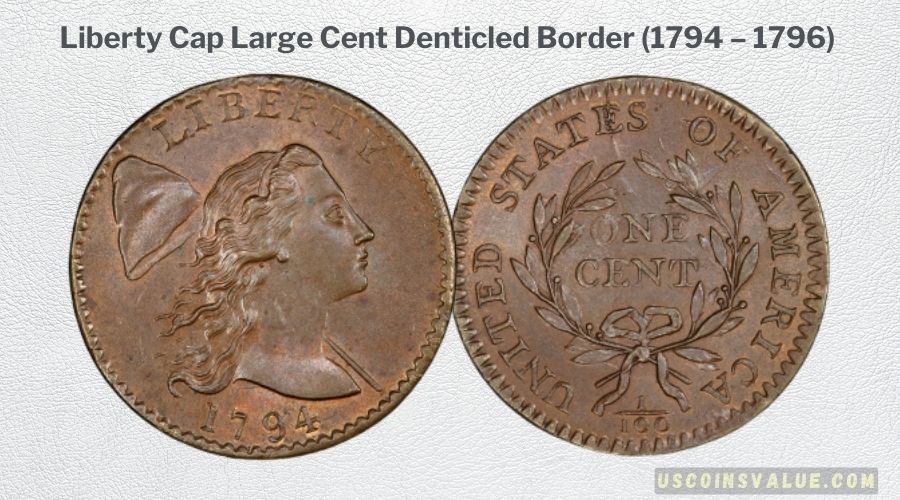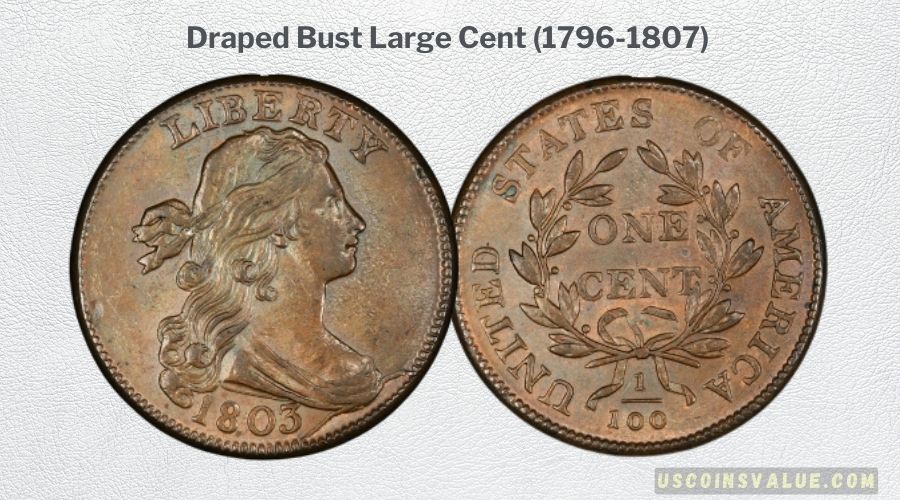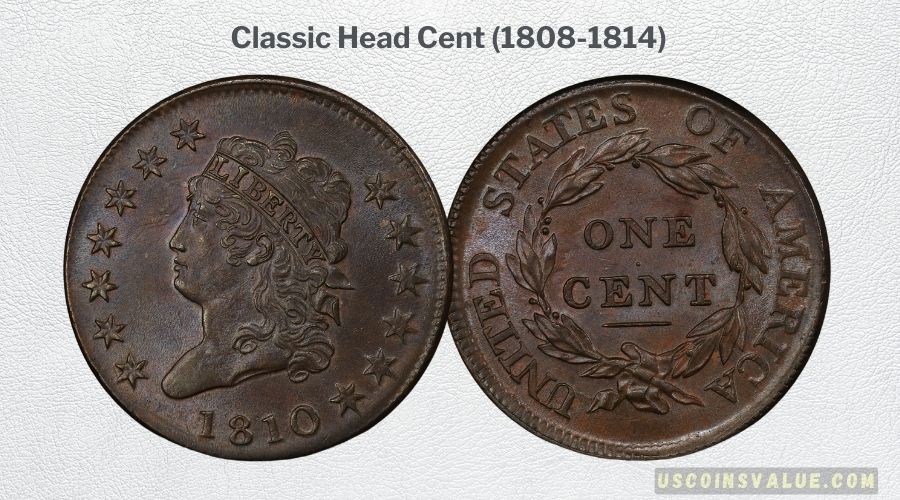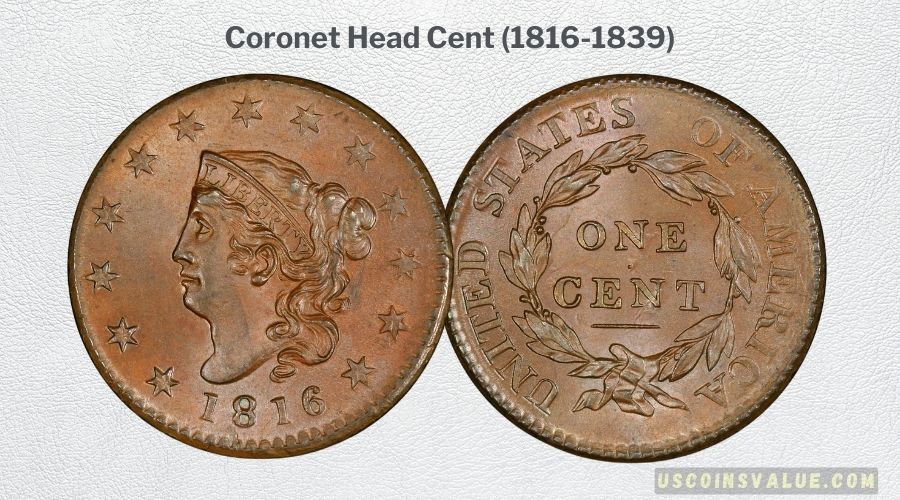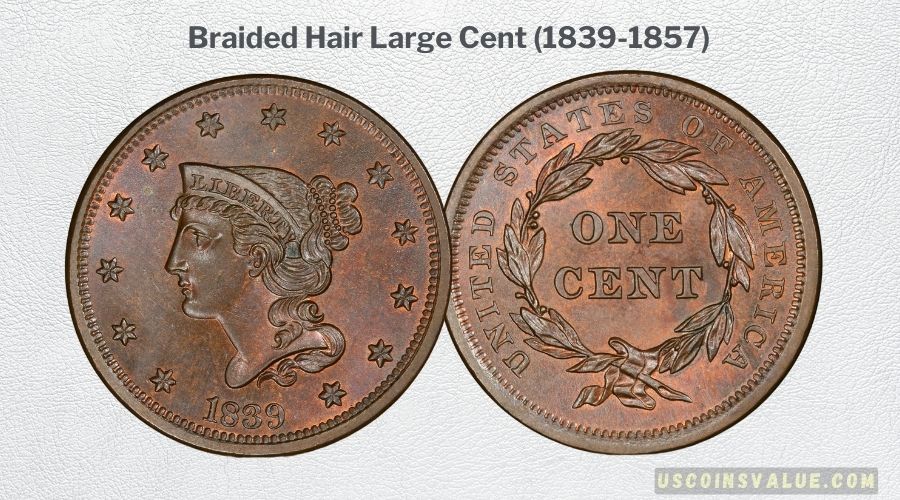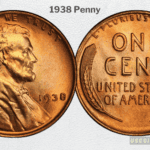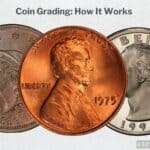Large Cents are large pennies, with a diameter between 26.5 mm and 28.57 mm, issued in the United States for over six decades from 1793 to 1857. A total of six large cent varieties were created during that time, each with varying designs.
Below are the six types and their estimated value today:
- Flowing Hair Large Cent (1793) – worth $4,500 – $2,500,000
- Liberty Cap Large Cent (1793 – 1796) – worth $465 – $1,500,000
- Draped Bust Large Cent (1796 – 1807) – worth $90 – $560,000
- Classic Head Large Cent (1808 – 1814) – worth $120 – $10,000
- Coronet Head Large Cent (1816 – 1839) – worth $35 – $115,000
- Braided Hair Large Cent (1839 – 1857) – worth $25 – $10,500
Large cents are highly valuable mainly because of their historical significance. Collectors and numismatic enthusiasts like us also value them because of their intriguing artistic designs.
Wondering what is the composition of a large cent? This article will answer that question and other large cent-related queries, including the large cent size, individual large cent values, and the various large cent subtypes.
Why Large Cents are Highly Collectible & Valuable
With an initial face value of one cent, large cents have survived to become among the world’s most prized possessions.
Currently, large coins are worth as little as $25; this is the value of the lowest-quality coin that isn’t highly collectible. The price increases to $2,500,000 for the highest-quality, most pristine coin that is highly collectible for various reasons. I dive into the reasons below:
1. Historical Significance
The world’s most valuable large cent is an MS66 grade 1793 Flowing Hair Large Cent, which sold for a whopping $2,350,000 in 2015.
In fact, on the top 10 list of most valuable large cents, the list mostly included 1793 coins.
This is partly because the Flowing Hair Large Cent was the first coin produced in the newly formed United States Mint in Philadelphia. The Coinage Act of 1792 drafted the most sustainable coin production system in America that has lasted to date, and the 1793 large cents mark its beginnings.
Today, large cents appeal to collectors due to their immense historical value.
If you want coins that speak to the struggles and triumphs of the new Union in the late 1700s and early 1800s, then the large cents are must-have collectibles. They provide insights into the economic and political changes of the 18th and 19th centuries.
2. Intriguing Artistic Designs
Large cents measure between 26.5 mm – 28.57 mm in diameter, making them significantly larger than modern-day pennies, hence the name. This in itself makes the design of the coin highly collectible.
Nevertheless, large cents also underwent numerous attractive design changes over the years, providing collectors with a wide range of aesthetic options. The design variations are vast, appealing to collectors’ diverse tastes.
For example, large cents made between 1793 and 1807 have a unique detail I like – they are the only large coins to feature two denomination engravings: ‘ONE CENT’ and “1/100”.
3. Limited Mintage
The Flowing Hair Large Cent was only minted in 1793. This makes it the rarest coin in the entire series, increasing its collectability and value.
Also, back then, most large cent coins were minted in the hundreds of thousands at most instead of the millions of cents produced each year today.
Braided Hair, the Coronet, and Classic Head Large Cents have the highest mintage than the first two. This makes them much cheaper and easier to obtain.
4. Rare Large Cent – Key Dates, Varieties & Errors
Die varieties and mint errors occurred in the making of the large pennies. This ranges from common die chips to strike-through errors, off-center, and DDO varieties.
The rare the error, the more expensive it is.
Key Dates also make coins rare. 1793 is the only Key Date for the large cent, a date with the rarest and hardest-to-find coins. This is because the mintage was low, and collectors covet 1793 pennies for their historical significance.
5. Condition & Grade
High-grade large cents are most sought after and command the most premium prices.
The most expensive large cents are in Mint State (MS) conditions, usually above MS63 on the Sheldon Scale. The color also judges the condition; Red (RD) is of higher quality, hence more collectible, followed by Red Brown (RB), and then Brown (BN).
Since they were made over 165 years ago, large pennies have circulated for centuries and aren’t in the best conditions. The highest grades you can find are MS66 and MS67.
Note that the lowest grades are still very valuable, particularly for the 1793 Key Date. On PCGS, the price valuation for an MS01 large cent is at least $1,000.
Large Cent Varieties
Varieties for large pennies include:
1. Flowing Hair Large Cent (1793)
This rare series was among the first coins to depict Ms. Liberty’s obverse design, bearing the portrait of Lady Liberty with her hair flowing. On the reverse, two designs were made during that year, giving us two subtypes of the Flowing Hair Large Cent:
- Chain Reverse (1793)
The Chain Reverse variety was the first version of the coin to be produced in 1793. It features 15 chain links on the reverse side of the coin, meant to symbolize the unity of the newly formed United States.
However, the coin was not well received since some saw the chain as a symbol of slavery, a sensitive issue in the early United States. This negative public reaction influenced the decision to modify the design. Only 36,103 pieces were made.
- Wreath Reverse (1793)
The Wreath Reverse appeared in 1793, replacing the criticized Chain Reverse. It features a wreath on the reverse side of the coin, intended to represent peace.
The obverse was also tuned to give Liberty longer and thicker hair.
Only 63,000 pieces were made.
2. Liberty Cap Large Cent (1793 – 1796)
The US Mint quickly replaced the Flowing Hair Large Cent since it wasn’t well received. They embarked on redesigning it into a more attractive coin with the Liberty Cap series in the same year.
The new Liberty Cap series is distinctive, with the obverse image of Liberty with lush, thicker, and wilder hair tamed in a Phrygian cap, symbolizing freedom. The reverse retained the wreath design but included two changes that made the two varieties of the Liberty Cap series:
- Beaded Border (1793)
The unique reverse in this variety features a beaded border on a decorative set of raised beads around the coin’s outer rim, making a beaded border.
- Denticled Border (1794 – 1796)
This reverse design featuring a denticled border was more durable. Denticled border consisted of a toothlike raised border instead of the raised beads. It was created to replace the first one, which needed to be more durable.
3. Draped Bust Large Cent (1796-1807)
Designed by Chief Engraver Robert Scot, the obverse design of the Draped Bust Large Cent features a right-facing bust of Liberty. Liberty is depicted wearing a draped garment that covers her bust and flows over her left shoulder, giving the design its name.
The reverse of the coin depicts the classic wreath with the words “UNITED STATES OF AMERICA” above it and the denomination “ONE CENT” in the middle.
4. Classic Head Cent (1808-1814)
This is the first large cent with an obverse image of Liberty facing left instead of right.
The Classic Head Cent was minted between 1808 and 1814 and was designed by John Reich, who was assistant to Chief Engraver Scot. The Classic Head derives its name from the fillet worn by Liberty on the obverse.
Several changes were made to the design, including a crosslet rim design change in 1814 that replaced the plain rim design from before.
5. Coronet Head Cent (1816-1839)
As you can tell, no large cents were minted in 1815. This is because the shipment of copper was affected when we declared war in 1912 against Great Britain, from where we imported the copper. It also didn’t help that copper was hoarded during the war, leading to a limited supply of planchets.
Also known as the Matron Head Large Cent or just Matron Head Cents, this coin debuted in 1816, featuring a relatively simple design compared to previous Large Cents.
The obverse features Ms. Liberty wearing a coronet, hence the name “Coronet Head.” “LIBERTY” is inscribed on the coronet, and she is surrounded by stars representing the states of the Union, and the date of the coin appears below the portrait of Liberty.
Conversely, the reverse design features a wreath that encircles “ONE CENT” at the center.
6. Braided Hair Large Cent (1839-1857)
The Braided Hair Large Cent is the final variety of Large Cent.
The obverse featured a beautiful image of a slimmer and more youthful Lady Liberty with her hair braided and coiled around her head.
The coin’s reverse depicts a wreath with the words “UNITED STATES OF AMERICA” above it and the denomination “ONE CENT” in the middle.
Large Cent Value
So, how much is a large cent worth? Each type and variety is valued differently, and the price increases if it is rare, has an error, has a low mintage, or has higher historical significance.
More than $100,000 is rare, and more than $1,000 is common.
1. Flowing Hair Large Cent Value
If you are looking for the most expensive large cent, then this is it.
On Heritage Auctions, I found the second finest PCGS-certified large cent that sold for a whopping $2,350,000. This is just one of more than a dozen Flowing Hair Large Cents that occupy the top list of most valuable large cents of all time.
A quick look on US Coin Book showed me the least expensive versions are worth $4,500. These are coins in the lowest Good G-4 grade (heavily worn with many decimated features). For a Mint State coin, like MS60 or above, you will have to spend more than $80,000, with most selling for more than $200,000.
A highly collectible Flowing Hair Large Cent is worth $2,500,000 in the best possible quality.
Take care not to buy fictitious coins on eBay. I noticed several worn pieces for less than $1,000 that look too good to be true and probably are. For an authentic piece, be ready to pay at least $1,100 or more. A Fine F-12 grade coin will cost you more than $10,000.
Highest auction examples for the Flowing Hair Large Cent
| Grade | Price | Firm | Year |
| MS66 BN | $2,350,000 | Heritage Auctions | 2015 |
| MS64+ BN | $1,500,000 | Heritage Auctions | 2019 |
| MS65 BN | $1,380,000 | Heritage Auctions | 2012 |
| MS65 BN | $998,750 | Stack’s Bowers | 2013 |
| MS65 BN | $990,000 | Heritage Auctions | 2018 |
2. Liberty Cap Large Cent Value
These are the second most expensive large cents. They were issued for only three years, making them more accessible than Flowing Hair cents but much scarcer compared to the rest of the coins in the series. You can obtain them easily, but they still demand a more premium price.
The lower mintage and two major design changes during their issuance make them good pieces to have in your collection.
According to PCGS, Liberty Cap coins in MS03 are worth around $465. Any coin above MS60 is worth $50,000 or more.
The highest grades are MS66 and MS67, both worth more than $400,000. The most valuable is worth $1,500,000.
After a quick glance at eBay, I recommend you stick to coins in the G-4 grades if you are on a budget. Finer coins in higher grades are premium but also tend to be overpriced on eBay. For a sizeable collection, stick to the lower grades to finish your set within budget.
Highest auction value for the Liberty Cap Large Cent
| Grade | Price | Firm | Year |
| AU58 | $940,000 | Stack’s Bowers | 2017 |
| MS64 BN | $881,250 | Stack’s Bowers | 2013 |
| MS66+ RB | $705,000 | Stack’s Bowers | 2017 |
| AU55 | $632,500 | Heritage Auctions | 2008 |
| MS67 RB | $449,375 | Stack’s Bowers | 2013 |
3. Draped Bust Large Cent Value
Over 16 million Draped Bust coins were minted. They are cheaper than the first two, and you can get a G-4 Good Condition coin for about $90.
According to the US Coin Book, the most valuable coin is the MS60 grade 1804 P Large Cent, worth $560,000.
There are a few notable errors and varieties that increase their value, including the popular ‘LIHERTY’ coin that had a die error that misprinted ‘LIBERTY’. An AU58 PCGS-graded coin in the variety sold for $80,000 in 2008.
Highest auction value for the Draped Bust Large Cent
| Grade | Price | Firm | Year |
| MS66 RD | $470,000 | Stack’s Bowers | 2015 |
| MS63 BN | $661,250 | Goldberg Auctioneers | 2005 |
| MS66+ BN | $329,000 | Stack’s Bowers | 2017 |
| AU55 | $305,500 | Stack’s Bowers | 2017 |
| MS67 RB | $282,000 | Stack’s Bowers | 2017 |
4. Classic Head Large Cent Value
The copper used during the years in which Classic Head cents were minted was of a higher quality, which made them softer and more prone to wear and corrosion. As a result, high-grade specimens are difficult to obtain and fetch high premiums when they appear on the market.
The highest grades are mostly in EU conditions and priced at around $10,000.
I found some on eBay selling for $30 – $500 in Good Condition, which is about what the G-4 grades are valued on PCGS and other grading companies.
Highest auction value for the Draped Bust Large Cent
| Grade | Price | Firm | Year |
| MS65 RD | $493,500 | Stack’s Bowers | 2017 |
| MS65 BN | $211,500 | Stack’s Bowers | 2013 |
| MS67 BN | $158,625 | Heritage Auctions | 2015 |
| MS64 BN | $129,250 | Goldberg Auctioneers | 2013 |
| MS65 RB | $90,000 | Stack’s Bowers | 2013 |
5. Coronet Head Large Cent Value
Over 60 million were minted between 1816 and 1839, making them a cheap option for collectors. You can find one for as low as $35 in Good G-4 condition. Unlike its predecessor, this series has a high number of quality coins up to MS63; any grade higher is hard to find.
MS63 coins are worth more than $5,000 and can fetch up to $115,000.
A fascinating part of Coronet Head coins is that there are MS60-rated coins worth less than $800.
Highest auction value for the Coronet Head Large Cent Value
| Grade | Price | Firm | Year |
| MS66 BN | $376,000 | Stack’s Bowers | 2017 |
| Ms66+ RB | $105,750 | Stack’s Bowers | 2017 |
| MS65 BN | $76,375 | Stack’s Bowers | 2017 |
| MS67 BN | $72,000 | Stack’s Bowers | 2020 |
| MS66 BN | $70,500 | Stack’s Bowers | 2017 |
6. Braided Hair Large Cent Value
More than 70 million pieces were minted, making it the most accessible large cent collection. If you are looking for the most affordable pieces for your collection, then this is where you start.
Braided Hair cents are worth $25 – $10,500. You can buy MS60 coins for as low as $500, but any coin above MS66 will cost you more than $9,000.
Highest auction value for the Braided Hair Large Cent Value
| Grade | Price | Firm | Year |
| MS66 RD | $94,000 | Stack’s Bowers | 2017 |
| MS65 RD | $76,375 | Stack’s Bowers | 2013 |
| MS65 RD | $38,187.50 | Stack’s Bowers | 2013 |
| MS65 RD | $36,000 | Heritage Auctions | 2022 |
| MS66 RB | $27,025 | Stack’s Bowers | 2013 |
Conclusion
If you are a newbie collector, start with budget-friendly collection schemes like the Type Set collection.
Collecting a complete large cent set can be costly. Type Set is a budget-friendly option where you only collect the lowest grades in each type and variety of the Large Cent Series.
Collecting the complete set can still be a massive task if money is no issue and you want the best quality.
A good way to lessen the tediousness is to break it into subsets; start with the more common Braided Hair Cent before moving to the scarcer Flowing Hair Chain Reverse Cents.

